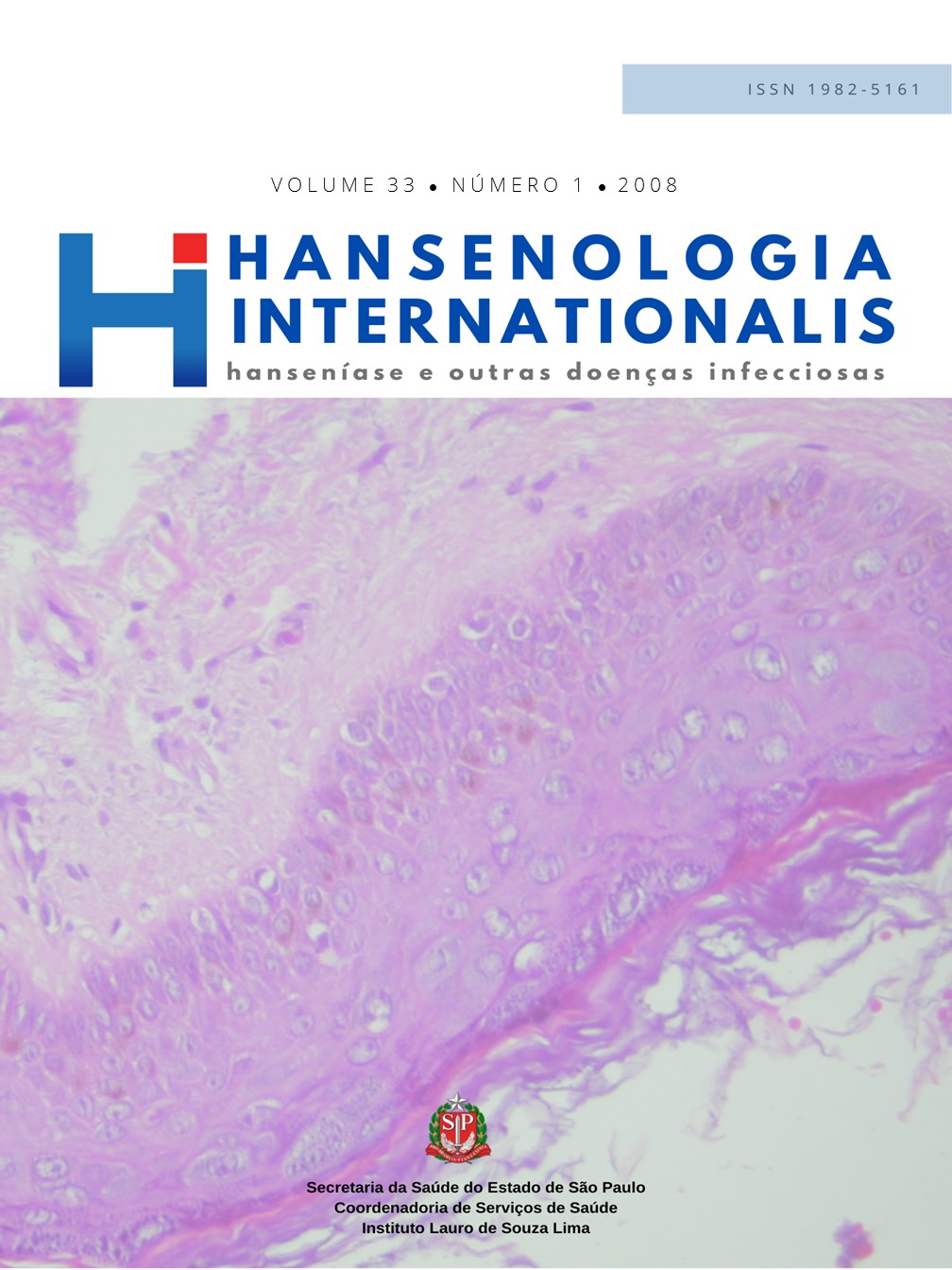“Ab initio” ulcerated erythema multiforme-like type 2 reaction: an atypical presentation of leprosy in the lepromatous range
DOI:
https://doi.org/10.47878/hi.2008.v33.35177Keywords:
Lepromatous leprosy, Erythema nodosum leprosum, Multidrug therapyAbstract
A 49 years old white man comes from a city of the inner part of the state of São Paulo with the diagnosis of multibacillary leprosy under treatment for 2 months. He reported that 2 years before he noted loss of sensitivity on his left foot which was associated with several red and hypopigmented macules with disturbance of skin sensitivity. The disease evolved with axillary and inguinal lymphadenopathy, as well as tender sharp borders’ plaques and ill-defined nodules, some of then ulcerated, and high degree fever also occurred. He was then admitted into a general hospital, and empirical antibiotics were started, without improvement of symptoms. An evaluation by an infectologist was requested, and the diagnosis of reactional multibacillary leprosy was made after skin smears and skin biopsy were performed. Multibacillary multidrug therapy (MDT-MB) was started,
as well as prednisone, with clinical improvement, but diabetes mellitus induced by prednisone occurred, and the patient was referred to the “Instituto Lauro de souza Lima” (ILSL). At admission, on the physical examination, other than the plaques, nodules and mild inguinal and axillary lymphadenopathy, the patient did not present classical findings of lepromatous leprosy, i.e., madarosis, difuse infiltration of skin, saddle nose, well-defined enlargement of periferal nerve trunks or even important disturbance of sensitivity on his limbs. Histopathologic examination of a skin biopsy collected from the border of a plaque showed leprosy on the lepromatous range with Type 2 reation, and the infiltrate was distributed mainly in the superficial dermis (erythema multiforme-like ENL), bacilloscopy 5+ (fragmented bacilli). Bacilloscopy of skin smears collected from index points was positive in all the 6 points, showing 3-4 +, with fragmented bacilli. ELISA for IgM anti-PGL-1 (phenolic glycolipid-1) was 0,241 and ML-Flow test (lateral flux test for M. leprae) was 4+. Hemogram showed severe anemia (Ht=26%), leucocytosis with left deviation with toxic granules inside the neutrophils, and the ESR=101mm. Bacteriological examination
of a swab collected from an ulcerated lesion showed S. aureus coagulase negative. Prednisone was reduced and thalidomide 300mg/day was added, with fast involution of the lesions. It is discussed the delay in the diagnosis despite the initial clinical findings, as well as the typical type 2 reactional features, the therapeutic procedures, and the pathogenesis of the type 2 reaction occurred before the begining of Multidrug therapy (MDT).
Downloads
References
2 Opromolla DVA, ed. Noções de Hansenologia. Bauru: Centro de Estudos “Dr. Reynaldo Quagliato”; 2000.
3 Machado AM. Eritema multiforme na hanseníase: uma reação tipo 2. Estudo histomorfométrico da vasculopatia do quadro reacional. [Tese de Doutorado]. Rio de Janeiro: FIOCRUZ; 2000.
4 Jacobson RR. Treatment of leprosy. In: Hastings. RC, editor. Lepros. 2nd ed. New York: Churchill Livingstone; 1994. p. 317-49.
5 Rea TH, Levan NE, Schweitzer RE. Erythema nodosum leprosum in the absence of chemotherapy: a role for cellmediated immunity. Lancet 1972; (2):1252.
6 Moraes MO, Sampaio EP, Nery JAC, Saraiva BCC, Alvarenga FBF, Sarno EM. Sequential erythema nodosum leprosum and reversal reaction with similar lesional cytokine mRNA patterns in a borderline leprosy patient. Br J Dermatol 2001; (144): 175-81.
7 Pfaltzgraff RE, Ramu G. Clinical Leprosy. In: Hastings RC, editor. Leprosy. 2nd ed. New York: Churchill Livingstone; 1994. p. 237-87.
8 Ridley DS. Skin biopsy in leprosy. 2nd ed. Switzerland: CIBAGEIGY; 1987.
9 Bührer-Sékula S, Sarno EN, Oskam L, Koop S, Wichers I, Nery JAC, et al. The use of ML Dipstick as a tool to classify leprosy patients. Int J Lepr Other Mycobact Dis 2000; (68):456-63.
10 Ramu G, Dharmendra. Acute exacerbations (reactions) in leprosy. In: Dharmendra. Leprosy. v.1. Bombay:Kothari Medical
Publishing House; 1978. P.108-39.
Downloads
Published
How to Cite
Issue
Section
License
This journal is licensed under a Creative Commons Attribution 4.0 International License.


























